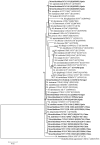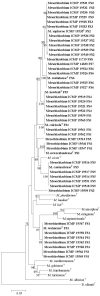Specificity in Legume-Rhizobia Symbioses
- PMID: 28346361
- PMCID: PMC5412291
- DOI: 10.3390/ijms18040705
Specificity in Legume-Rhizobia Symbioses
Abstract
Most species in the Leguminosae (legume family) can fix atmospheric nitrogen (N₂) via symbiotic bacteria (rhizobia) in root nodules. Here, the literature on legume-rhizobia symbioses in field soils was reviewed and genotypically characterised rhizobia related to the taxonomy of the legumes from which they were isolated. The Leguminosae was divided into three sub-families, the Caesalpinioideae, Mimosoideae and Papilionoideae. Bradyrhizobium spp. were the exclusive rhizobial symbionts of species in the Caesalpinioideae, but data are limited. Generally, a range of rhizobia genera nodulated legume species across the two Mimosoideae tribes Ingeae and Mimoseae, but Mimosa spp. show specificity towards Burkholderia in central and southern Brazil, Rhizobium/Ensifer in central Mexico and Cupriavidus in southern Uruguay. These specific symbioses are likely to be at least in part related to the relative occurrence of the potential symbionts in soils of the different regions. Generally, Papilionoideae species were promiscuous in relation to rhizobial symbionts, but specificity for rhizobial genus appears to hold at the tribe level for the Fabeae (Rhizobium), the genus level for Cytisus (Bradyrhizobium), Lupinus (Bradyrhizobium) and the New Zealand native Sophora spp. (Mesorhizobium) and species level for Cicer arietinum (Mesorhizobium), Listia bainesii (Methylobacterium) and Listia angolensis (Microvirga). Specificity for rhizobial species/symbiovar appears to hold for Galega officinalis (Neorhizobium galegeae sv. officinalis), Galega orientalis (Neorhizobium galegeae sv. orientalis), Hedysarum coronarium (Rhizobium sullae), Medicago laciniata (Ensifer meliloti sv. medicaginis), Medicago rigiduloides (Ensifer meliloti sv. rigiduloides) and Trifolium ambiguum (Rhizobium leguminosarum sv. trifolii). Lateral gene transfer of specific symbiosis genes within rhizobial genera is an important mechanism allowing legumes to form symbioses with rhizobia adapted to particular soils. Strain-specific legume rhizobia symbioses can develop in particular habitats.
Keywords: Leguminosae; N2 fixation; lateral gene transfer; nod genes; nodulation.
Conflict of interest statement
The authors declare no conflict of interest.
Figures




References
-
- Lewis G.A., Schrire B.B., Mackinder B.C., Lock M.D. Legumes of the World. Kew; Royal Botanic Gardens, London, UK: 2005.
-
- Sprent J.I. Legume Nodulation A Global Perspective. Wiley Blackwell; Chichester, UK: 2009.
-
- LPWG Legume phylogeny and classification in the 21st century: Progress, prospects and lessons for other species-rich clades. Taxon. 2013;62:217–248.
-
- Cardoso D., Pennington R.T., de Queiroz L.P., Boatwright J.S., van Wyk B.-E., Wojciechowski M.F., Lavin M. Reconstructing the deep-branching relationships of the papilionoid legumes. S. Afr. J. Bot. 2013;89:58–75. doi: 10.1016/j.sajb.2013.05.001. - DOI
-
- LPWG A new subfamily classification of the Leguminosae based on a taxonomically comprehensive phylogeny. Taxon. 2017;66:44–77.
Publication types
MeSH terms
Substances
LinkOut - more resources
Full Text Sources
Other Literature Sources
Miscellaneous

